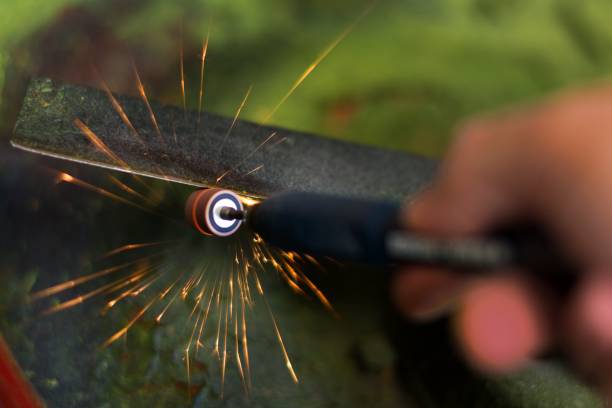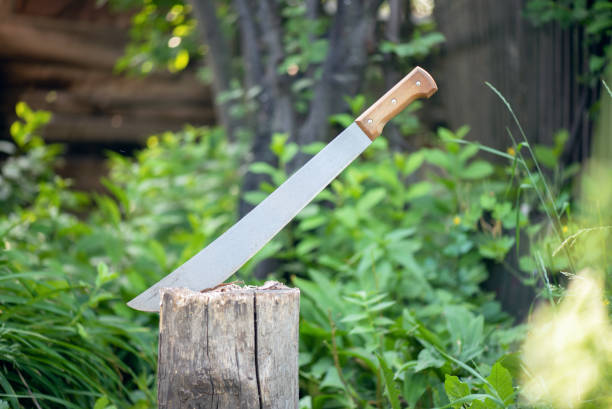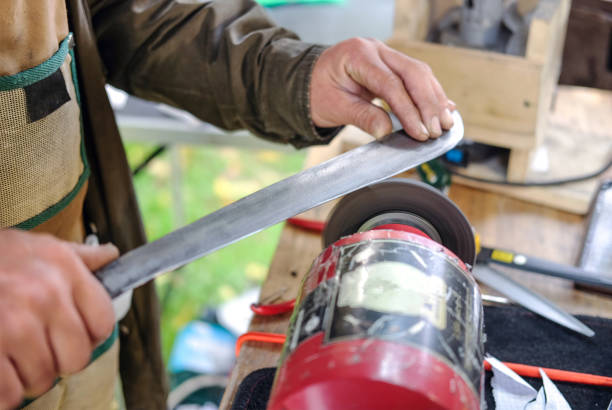You’ve probably used a machete; they’re a common type of knife. The bush on a farm, unwanted branches, and hedges can all be cut with a machete. You must first learn how to sharpen a machete, though.
Because of their size and shape, machetes are strong tools. The typical machete is 0.2 inches thick and between 20 and 24 inches long. You could always purchase a new blade if yours becomes dull. And yet, why spend the cash? Most people will find it more helpful to know how to sharpen a machete, even if they don’t need a razor-sharp edge.
Tools to Sharpen a Machete
File
A file ought to be the first tool you try if you’re just learning how to sharpen a machete. This is an easy-to-use tool that is not specialized. The mill file—often used to sharpen blades—is the best kind of file to use.
The knife should be put in a vice for the best results. This holds the knife in place and adjusts its angle, giving you the desired result. If you don’t have a vice, you can hold the machete in your hands or, if you’re skilled, on another surface. Simply keep pushing the file over the blade.
Grinder
Using a grinder is the best option if you want a razor-sharp machete. Any dullness and larger nicks will be removed using a grinder. If you’re restoring an old machete, grinders are also perfect. The only drawback is how much work a grinder requires, so it’s best if you’ve used one before.
A roomy workspace is another important factor to consider. To get a straight edge, cross the machete over the grinder. Be aware that the machete can easily overheat; therefore, use a slow grinder or submerge it in water. Even some claim that using a grinder to sharpen ruins the edge of the machete.
Whetstone
For beginners, the whetstone technique is also advised. This is the traditional way to sharpen a machete, and it doesn’t require much expertise or special equipment. The only tool you’ll need is a special whetstone, though a regular water stone will also do. You only need to raise and lower the blade in relation to the stone.
Dremel
A Dremel is a portable power tool with a knife sharpener on the end of the shaft. Although it seems difficult, beginners can manage it without much difficulty. The technique’s only drawback is that it frequently produces an uneven edge. Put the knife in a vice and smooth the blade with the Dremel.

How to Sharpen a Machete
Get the Motion Down
The machete will be passed over the tool in the same motion no matter what the tool is. Run the blade from the hilt to the tip, starting at the hilt. You should move in accordance with the blade’s organic curve. If you need to lean forward to reach this curve, don’t be surprised.
Set the machete in a vice to achieve the desired angle if you want a particular perspective.
Change Sides
A machete’s edges should be sharpened on both sides, not just the one you’ll probably use to cut. Sharpen the opposite side as well. Then proceed down the opposite side of the machete by turning it over.
You can skip this step if you’re a novice or don’t use your machete frequently. This is due to the fact that sharpening this side is a little different. Since there is less of a curve on the top side, you must sharpen it differently.
It might take a little while to get used to sharpening the top side. A precise and even blade is produced by honing the side that is less dominant.
Hone the Edge
A nice, sharp point is provided by honing the edge of your machete. Bringing your machete to a sharp point is all that is required for this simple motion, which begins at the edge and moves down slightly from the tip.
Polishing the Edge
Though not required, this step is beneficial.
The only drawback to sharpening a machete is that occasionally imperfections result from the procedure. By polishing the machete, particularly the edge, you can get rid of these flaws. Using a buffing wheel is the ideal method for polishing the machete.
Moving the machete perpendicularly across the wheel, place the flat edge of the blade against the buffing wheel. Apply this to the machete’s two sides.
Test the Machete
The fun part will now begin! You should test the machete to make sure the blade is sufficiently sharp. Cutting a 2×4 is the most effective way to test a machete. Try to cut the 2×4 in half.
The paper trick can be used if not. The paper should be run along the machete’s edge. You should sharpen your machete even more if it drags the paper rather than cutting it.
Repeat steps 1-4 while using your preferred tool. A diamond stone can be used to further sharpen the edge and blade.

How to Sharpen a Gerber Machete
When you first get a machete, sharpening it can seem particularly difficult. It’s always best to get in touch with the Gerber company and ask about maintenance requirements for the machete you have if you want to know how to sharpen it. Gerber machetes come in a variety of styles and sizes, and their knives are quite well-liked.
There isn’t a single method that can be used to make them all sharp. You can easily use a sander or a grinder for machetes that have a straight edge. Things become more challenging when using machetes with hooked or serrated edges, though.
For those, you can try using a file or sharpening stones, or if the task seems too difficult, you can send it to a professional for sharpening. Every Gerber machete includes a sheath, and some even include a sharpening stone. Utilize these to maintain the machete’s condition throughout the year.
Conclusion: A Very Useful Tool
A machete is by definition a very useful tool for someone who enjoys being outside or even someone who likes to garden. A dull machete would be more of a challenge to use in either situation. Thus, mastering machete sharpening was necessary. Do you feel assured that you can properly care for your machete now? Please let me know if you were able to sharpen your machete.
FAQs
What is the Best Thing to Sharpen a Machete?
Large blades can be sharpened with mill files because they don’t require excessive force, which could harm a machete used by a beginner.
What Angle Do You Sharpen a Machete At?
Depending on how you plan to use your machete, you should choose a particular blade angle. Smaller blade angles of 25 degrees are ideal for light grass and vegetation cutting because they allow for sharper edges. Larger angles up to 35 degrees work well to take the impact for heavier chopping tasks like wood.
What Are the Holes in Machetes For?
Cutting through bone is simple thanks to the hole in the sturdy blade. The upper part can be held with your fingers thanks to the hole. You can pull the blade free by tightening your hold on the handle.

